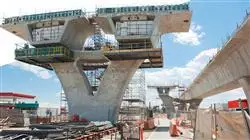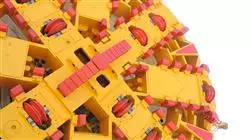University certificate
Scientific endorser

The world's largest faculty of engineering”
Introduction to the Program
Stand out in the field of Structural and Construction Engineering by incorporating the most advanced analysis and project management tools into your work methodology"

Technological advances have enabled Structural and Construction Engineering to take giant steps forward. Smarter urbanization, increasing automation of machinery, or the use of Big Data in the analysis of structures are just some of the consequences that have resulted from the most innovative developments in recent years.
Engineers are facing a favorable performance scenario since they have tools, work methodologies, and construction techniques that allow much more agile, deep, and organized work. This also forces them to a process of continuous renewal, which is essential to keep up to date in order to continue advancing professionally and build stronger and, more importantly, working relationships.
For this reason, TECH has created this program, which presents the most outstanding advances in topics such as construction materials, building, structural analysis, and project management. The engineer will have access to a multitude of topics detailing the improvement of dynamic behavior, modular construction, alternative foundation methods, or the most modern software in project drafting.
In addition, the format of the qualification is completely online, as all the contents can be downloaded directly from the Virtual Campus. This means that it is the engineer who sets the pace of study, being able to adapt the teaching load to their own professional and personal responsibilities. The multitude of real cases analyzed, the audiovisual materials, and the meticulous and exhaustive detail with which each topic has been elaborated will be decisive in updating the engineer, giving a definitive boost to their professional career.
Delve into the latest developments in construction materials, including modules dedicated to building, deformable solid mechanics, and structural concrete"
This Professional master’s degree in Structural and Construction Engineering contains the most complete and up-to-date program on the market. The most important features include:
- The development of case studies presented by experts in Civil Engineering
- The graphic, schematic, and practical contents with which they are created, provide practical information on the disciplines that are essential for professional practice
- Practical exercises where self-assessment can be used to improve learning
- Its special emphasis on innovative methodologies
- Theoretical lessons, questions to the expert, debate forums on controversial topics, and individual reflection assignments
- Content that is accessible from any fixed or portable device with an Internet connection
Give a definitive boost to your professional career by incorporating this Professional master’s degree in your CV and stand out as an up-to-date and avant-garde structural engineer"
The program’s teaching staff includes professionals from sector who contribute their work experience to this educational program, as well as renowned specialists from leading societies and prestigious universities.
Its multimedia content, developed with the latest educational technology, will provide the professional with situated and contextual learning, i.e., a simulated environment that will provide an immersive education programmed to learn in real situations.
The design of this program focuses on Problem-Based Learning, by means of which the professional must try to solve the different professional practice situations that are presented throughout the academic course. For this purpose, the student will be assisted by an innovative interactive video system created by renowned experts.
You decide your own course load, taking the exams and advancing through the syllabus according to your own interests"

You choose how, when, and where to study at your own pace without face-to-face classes or fixed schedules"
Why study at TECH?
TECH is the world’s largest online university. With an impressive catalog of more than 14,000 university programs available in 11 languages, it is positioned as a leader in employability, with a 99% job placement rate. In addition, it relies on an enormous faculty of more than 6,000 professors of the highest international renown.

Study at the world's largest online university and guarantee your professional success. The future starts at TECH”
The world’s best online university according to FORBES
The prestigious Forbes magazine, specialized in business and finance, has highlighted TECH as “the world's best online university” This is what they have recently stated in an article in their digital edition in which they echo the success story of this institution, “thanks to the academic offer it provides, the selection of its teaching staff, and an innovative learning method aimed at educating the professionals of the future”
A revolutionary study method, a cutting-edge faculty and a practical focus: the key to TECH's success.
The most complete study plans on the university scene
TECH offers the most complete study plans on the university scene, with syllabuses that cover fundamental concepts and, at the same time, the main scientific advances in their specific scientific areas. In addition, these programs are continuously being updated to guarantee students the academic vanguard and the most in-demand professional skills. In this way, the university's qualifications provide its graduates with a significant advantage to propel their careers to success.
TECH offers the most comprehensive and intensive study plans on the current university scene.
A world-class teaching staff
TECH's teaching staff is made up of more than 6,000 professors with the highest international recognition. Professors, researchers and top executives of multinational companies, including Isaiah Covington, performance coach of the Boston Celtics; Magda Romanska, principal investigator at Harvard MetaLAB; Ignacio Wistumba, chairman of the department of translational molecular pathology at MD Anderson Cancer Center; and D.W. Pine, creative director of TIME magazine, among others.
Internationally renowned experts, specialized in different branches of Health, Technology, Communication and Business, form part of the TECH faculty.
A unique learning method
TECH is the first university to use Relearning in all its programs. It is the best online learning methodology, accredited with international teaching quality certifications, provided by prestigious educational agencies. In addition, this disruptive educational model is complemented with the “Case Method”, thereby setting up a unique online teaching strategy. Innovative teaching resources are also implemented, including detailed videos, infographics and interactive summaries.
TECH combines Relearning and the Case Method in all its university programs to guarantee excellent theoretical and practical learning, studying whenever and wherever you want.
The world's largest online university
TECH is the world’s largest online university. We are the largest educational institution, with the best and widest online educational catalog, one hundred percent online and covering the vast majority of areas of knowledge. We offer a large selection of our own degrees and accredited online undergraduate and postgraduate degrees. In total, more than 14,000 university degrees, in eleven different languages, make us the largest educational largest in the world.
TECH has the world's most extensive catalog of academic and official programs, available in more than 11 languages.
Google Premier Partner
The American technology giant has awarded TECH the Google Google Premier Partner badge. This award, which is only available to 3% of the world's companies, highlights the efficient, flexible and tailored experience that this university provides to students. The recognition as a Google Premier Partner not only accredits the maximum rigor, performance and investment in TECH's digital infrastructures, but also places this university as one of the world's leading technology companies.
Google has positioned TECH in the top 3% of the world's most important technology companies by awarding it its Google Premier Partner badge.
The official online university of the NBA
TECH is the official online university of the NBA. Thanks to our agreement with the biggest league in basketball, we offer our students exclusive university programs, as well as a wide variety of educational resources focused on the business of the league and other areas of the sports industry. Each program is made up of a uniquely designed syllabus and features exceptional guest hosts: professionals with a distinguished sports background who will offer their expertise on the most relevant topics.
TECH has been selected by the NBA, the world's top basketball league, as its official online university.
The top-rated university by its students
Students have positioned TECH as the world's top-rated university on the main review websites, with a highest rating of 4.9 out of 5, obtained from more than 1,000 reviews. These results consolidate TECH as the benchmark university institution at an international level, reflecting the excellence and positive impact of its educational model.” reflecting the excellence and positive impact of its educational model.”
TECH is the world’s top-rated university by its students.
Leaders in employability
TECH has managed to become the leading university in employability. 99% of its students obtain jobs in the academic field they have studied, within one year of completing any of the university's programs. A similar number achieve immediate career enhancement. All this thanks to a study methodology that bases its effectiveness on the acquisition of practical skills, which are absolutely necessary for professional development.
99% of TECH graduates find a job within a year of completing their studies.
Professional Master's Degree in Structural Engineering and Construction
.
At TECH Global University, we offer you the opportunity to become an expert in Structural Engineering and Construction through our online Professional Master's Degree. Discover how you can acquire the knowledge and skills necessary to excel in the exciting field of civil engineering and contribute to the design and construction of the structures of the future.
Start strengthening your professional profile
.
Studying online has numerous benefits, and at TECH Global University we have adapted our program to provide you with a quality educational experience from the comfort of your home or anywhere in the world. The online modality allows you to access the course content at any time and place, giving you the flexibility to organize your studies according to your needs and personal or professional commitments. By choosing our Professional Master's Degree in Structural Engineering and Construction, you will have access to a comprehensive and up-to-date curriculum, taught by experts in the field of engineering. You will learn about the fundamentals of structural strength and stability, load analysis and the application of innovative technologies in building design and construction. In addition, you will explore advances in building materials and sustainable design techniques, developing skills to create efficient and safe solutions. At TECH Global University, we focus on providing you with a comprehensive preparation that combines theoretical knowledge with practical applications. Through real projects and case studies, you will have the opportunity to apply your skills and face challenges unique to the field of structural engineering and construction. Earning a Professional Master's Degree in Structural Engineering and Construction will open doors to a wide range of career opportunities in engineering companies, consulting firms, architectural firms and public agencies. You will be able to participate in large-scale projects, contributing to the development of safe and sustainable infrastructures. Take a step forward in your professional career and become a reference in the field of structural and construction engineering. Join TECH Global University and acquire the necessary skills to design the future of construction.







